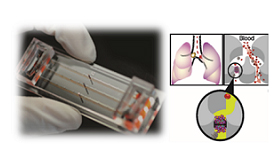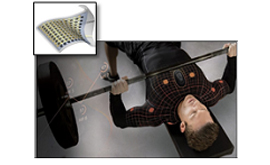Research
BioDr. Lab is developing novel aging study tools and studying cellular responses based on physical stimulations. The organs and tissues we focus on include skin, skeletal muscle, nerve and fat. By utilizing BioMEMS (microelectromechanical systems), bioelectronics, microfluidics and 3D bioprinting technologies, both implantable devices and cell stimulation biochips have been constructed.

Aging organ-on-a-chip (AOC)
It is very important to mimic the in vivo microenvironment of aged organs and tissues for aging recovery. Based on BioMEMS and 3D bioprinting technology, we create models of aged tissue including skin, muscle, neurons, etc. This system, the aging organ-on-chip (AOC), can by itself provide a valuable platform to clearly elucidate the mechanisms and modes of action for the aging process and recovery. There is great demand among the R&D departments of many cosmetic and pharmaceutical companies for these technologies, including AOC and artificial tissue fabrication. Moreover, various aging platforms including C. elegans, yeast, mammalian and plant cell models are also under active investigation and development.

3D bioprinting technology
Aging oragn-on-a-chip
Artificial tissue fabrication
Stimulation based rejuvenation
Aging cells intrinsically exhibit long doubling times: hence, are very rare. There are several kinds of physical stimulation sources including plasma, ultrasound, electric and magnetic fields, which comprises unlimited stimulation conditions. We have therefore created novel lab-on-a-chips for high throughput stimulation screening (HTSS), in order to analyze cellular responses on a massively parallel scale. BioDr. Lab is currently developing physical stimulation-based high throughput screening lab-on-a-chip platform to improve the function of aged primary skeletal muscle cells.
High throughtput simulation screening biochip

Aged stem cell activation
Tissue homeostasis and repair in aged organisms depends on aged stem cells which constitute a very limited population of undifferentiated long-lived cells in whole-body tissues. To increase the viability and functional performance of aging organisms, BioDr. Lab focuses on the activation of these aged stem cells staged in senescence, in particular studying the mechanism of stem cell reactivation and their response to key environmental stimuli. Currently, we are interested in reactivation of aged skeletal muscle stem cells and their response and molecular changes to such stimuli.

Cancer Diagnostics with Liquid Biopsy for Personalized Medicine
Cancer is among the leading causes of death worldwide. The number of new cancer cases per year is expected to rise to 23.6M by 2030. A liquid biopsy, also known as fluid biopsy, is the sampling and analysis of non-solid biological tissue, primarily blood. This method is mainly utilized as a diagnostic and monitoring tool for the diseases, with the added benefit of being largely non-invasive. There are several types of liquid biopsy, circulating tumor cells (CTC), cell-free tumor DNA (ctDNA), extracellular vesicles (i.e. exosomes and microvesicles). In our group, several types of CTC separation technologies including microfilters, immunomagnetics and centrifugal microfluidics (Lab-on-a-disc) have been developed and currently we are developing fully automated CTC isolation system to overcome the heterogeneity of cancers and expanding types of liquid biopsy samples toward tailored medicine and early detection.
Cancer immunotherapy technology
Cancer immunotherapy is the treatment using our own immune system to help fight cancer. The first step for successful cancer immunotherapy is the intact isolation of targeted immune cells with high recovery. We are developing a novel immune cell separation technologies for clinical utility. In addition, cell engineering platform to massively modulate the function of immune cells has been developed by the combination of microfluidics and automated robotics, finally maximizing the cancer killing effect of engineered immune cells.

IoT based bioelectronics
As our world has been turned into the 4th industrial revolution, the capability of information processing has now entered into nearly everything. Given that intelligent devices are getting smaller by virtues of nanotechnology, aging related nanobiosensors can be implemented in a wearable form-factor. BioDr. Lab is also paying attention to electroceuticals, implantable electronic devices designed to modulate biological systems for pharmaceutical purposes. We are developing a novel remote electroceutical to repair degeneration in the peripheral nervous system.

Nanobiosensor
Electroceuticals
Wearable electoronics




